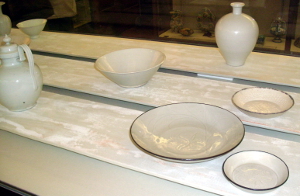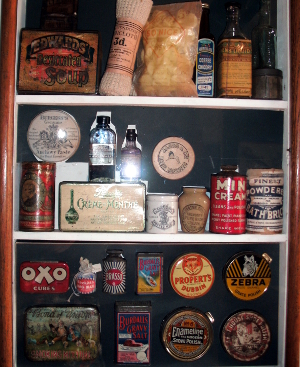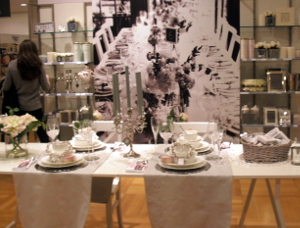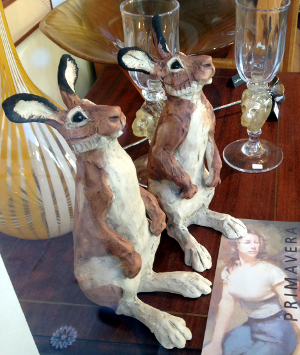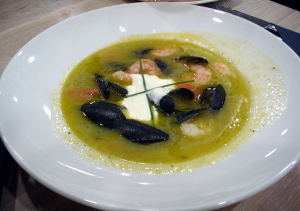|
This Spring we discovered interesting ceramics on display and in use throughout a superb trip to Cambridge. A special exhibition about the history of ‘white wares’ and porcelain was accompanied by a series of contemporary installations by the renowned potter Edmund de Waal who originally studied in Cambridge at the FitzWilliam Museum in Trumpington Street. |
|
|
Visiting several museums in Cambridge in turn, we were struck by the theme of how ceramics are timeless and important in our everyday lives. Clay and porcelain wares can be a thing of great beauty, with a very complex structure and construction method that has taken thousands of years to develop. Edmund de Waal’s installation “a thousand hours” (2012) displays hundreds of hand-thrown porcelain vessels in a pair of aluminium and plexiglass vitrines. Edmund de Waal communicates the time and struggle required to produce these unique artifacts and how that is part of the very skilled work of creating and firing ceramics. His works are installed against the backdrop of the galleries Chinese, Korean, Iranian collections some of which are thousands of years old. Edmund de Waal explains how
|
|
|
|
|
Ben & Winifred Nicholson’s paintings at Kettle’s Yard Gallery in Castle Street included landscapes, seascapes and ceramics in an exhibition entitled “Art and Life 1920 to 1931” Both Ben and Winifred Nicholson were married during these years and the modern, art and ceramics of close painting friends Christopher Wood, Alfred Wallis and William State Murray were also shown. In later years Ben Nicholson was married to Barbara Hepworth a well known British ceramicist. |
|
|
In their different ways and styles the Nicholson’s depicted ceramics in an honest way for example as vases or containers with flowers and objects found at the dining table. Their paintings showed the world they found around them, often describing the more rural parts of Britain they visited to paint together with friends during these years. Both Ben and Winifred explored modern ways of abstract painting which included elements of cubism and constructivism. Although represented in a 2D medium we are reminded of how ceramics were used and valued in everyday life during the 1920’s and 1930’s through their inclusion in these artworks. |
|
|
At the Cambridge and County Folk Museum in Castle Street, the charming 17th century building houses the domestic history of objects found in homes dating back to the 1600’s. Teapots, cups and plates from a bygone era are shown as well as pots for containing food items. Home life for previous generations of Cambridge inhabitants is exhibited in specially created rooms. The visitor takes a tour around the old house complete with nooks and crannies, winding staircases and creaking floorboards. Children enjoy playing with the old tea service and imagining how vintage pots, pans and equipment were used in the kitchen ‘in the old days’ before labour saving devices were invented.
|
|
|
The functionality and pleasing appearance of the ceramic items on display in the cabinets such as Hailwood’s pure rich cream and J Sainsbury’s potted meat just show what excellent and enduring product designs these items had. Often the quality and purity of a food or drink was conveyed by the specific type and branding of the pot. Whether fired with a glossy glaze or simply stone coloured, these containers were stamped with the makers name and logo. This method of adding a recognizable and reassuringly consistent makers seal is still used with many products today. |
|
|
John Lewis the renowned retail store at the Grand Arcade,10 Downing Street featured a eye-catching wedding table display at the china and glass department. One long, white outdoor table is set with a fine white porcelain range of contemporary tableware ready for four people to sit at a wedding banquet. White table linen is used and silver accents are added with charger plates and candlesticks. Traditional wedding gifts in pale colours are merchandised to either side of a black and white photo of a long wedding table to create the overall visual effect that one is invited to join in this special dining experience.
|
|
|
The fine china collection for sale at John Lewis is the focus here and it shows how ceramics are a key part of our best cultural celebrations.William Morris the Arts & Crafts designer famously advised. |
|
|
|
|
Primavera Studio Gallery, Magdalene Street showcased a pair of ceramic haresin their main window area. These hares are certainly beautiful and could well be described as delightful. They are not as functional as the other pieces we have touched upon. However they are useful in that they lift the spirits during Spring and the hares also highlight the uncertain future of an animal whose numbers are currently dwindling in the British Isles due to environmental changes. |
|
|
There are many different types of ceramic pieces to see on a brief tour of Cambridge. We found everything from priceless, irreplaceable and nearly impossible to produce antiquities from the Far East at the FitzWilliam, to the statement white china bowls our hearty fish soup was served in at lunch in the historic city centre. We are reminded that this 3 dimensional artform is enduring and definitely plays a part in our everyday lives in the 21st century.
|
|
| This tour has given us a new appreciation for the work of Edmund de Waal, the Nicholson’s and the culture and artistic collections in Cambridge as well as ceramics itself as a medium. We will now look at all things made of clay, china and porcelain more carefully and with fresh eyes. | |
| References: | |
|
1. Edmund de Waal 24/02/2014 “On White – Porcelain Stories from the Fitzwilliam Museum” Notes by the artist to accompany the exhibition.
|
|
|
2. William Morris “The Beauty of Life,” a lecture before the Birmingham Society of Arts and School of Design (19 February 1880), later published in Hopes and Fears for Art: Five Lectures Delivered in Birmingham, London, and Nottingham, 1878 – 1881 (1882). |
|
|
|||||
Rediscovering Ceramics in Cambridge |
|||||
|
©Create Display - All Rights Reserved 2024 Powered by WordPress & Atahualpa |
|||||

